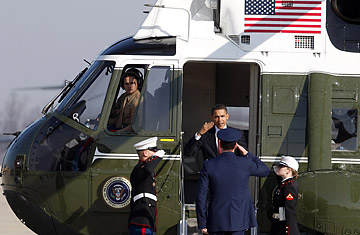The commander-in-chief is the top guy in the U.S. military. The Pentagon is at his beck and call, and salutes smartly when summoned to do his (for now) bidding.
That’s why the Pentagon’s re-do on the President’s personal helicopter – Marine One – is an apt focus Wednesday, when the Pentagon rolls out its budget request for the 2014 fiscal year.
Sometimes presidential orders can have remarkable changes, even in the arcane world of Pentagon procurement, a Government Accountability Office report released Tuesday makes clear.
President Obama cancelled his fleet of 28 VH-71 choppers in June 2009, after their cost soared from an estimated $6.5 billion in 2005 to $13 billion in 2009 — $464 million…each. That’s roughly the same price as the modified 747s known as Air Force One when the commander-in-chief is aboard.
“It is an example,” Obama said at the time, “of the procurement process gone amok.” He said he found his aging fleet of “white-tops” perfectly adequate. Most of their trips are short hops, like the 10 minutes between the White House and Andrews Air Force Base.
Only the Pentagon could turn a $60 million helicopter — the European-made EH-101 — into a $464 million whirlybird. The costs started climbing as the White House informed the Pentagon and its contractors of its wish list of encrypted video, telephone and electronic capabilities that it wanted aboard the new machines.

President Barack Obama steps off Marine One to board Air Force One at Andrews Air Force Base.
The post-9/11 need for security led to secret requirements for onboard jammers to thwart radars and missiles. Then there was the required shielding to help protect the choppers’ electronic guts from being fried by electromagnetic pulses generated by nuclear blasts (as well as separate systems to protect against biological and chemical weapons). The Navy, which buys all Marine aircraft, and its contractors simply saluted and passed on the escalating costs to the taxpayers, until the Obama Administration killed the program.
Four years later, the post-9/11 hysteria has died down. This time around, the Navy isn’t trying to build a new chopper from the ground up, and plans on relying on many proven technologies already flying for the presidential chopper fleet, the GAO said.
Bottom line: the Navy’s new approach “reflected additional trade-offs made among cost, schedule, risk, and performance.”
What a concept.
Those compromises – mind you, this is for the President’s helicopter – have led to the changes spelled out in the chart above between the aborted VH-71 chopper and the new VXX now under development:
— The number of passengers, the chopper’s range, transportability, operational availability, speed and hover performance all have been reduced.
Scaling back the VH-71’s capabilities has saved about 50% of the program’s projected cost. Additional modifications to a 2010 plan to build a new presidential helicopter will save 19.7% of the retooled program’s estimated $7.5 billion cost – about $1.5 billion – and cut the development schedule by about 18%.
Key takeaway: requirements that the Pentagon deemed vital for the VH-71 have disappeared in the VXX now coming to life on the drawing boards. It is slated to be flying Presidents in 2020, following a contract award next year.
No one is suggesting these scaled-back changes will in any way endanger the President, or hamper his ability to perform his mission.
Imagine if the Pentagon took that approach to its entire budget.


